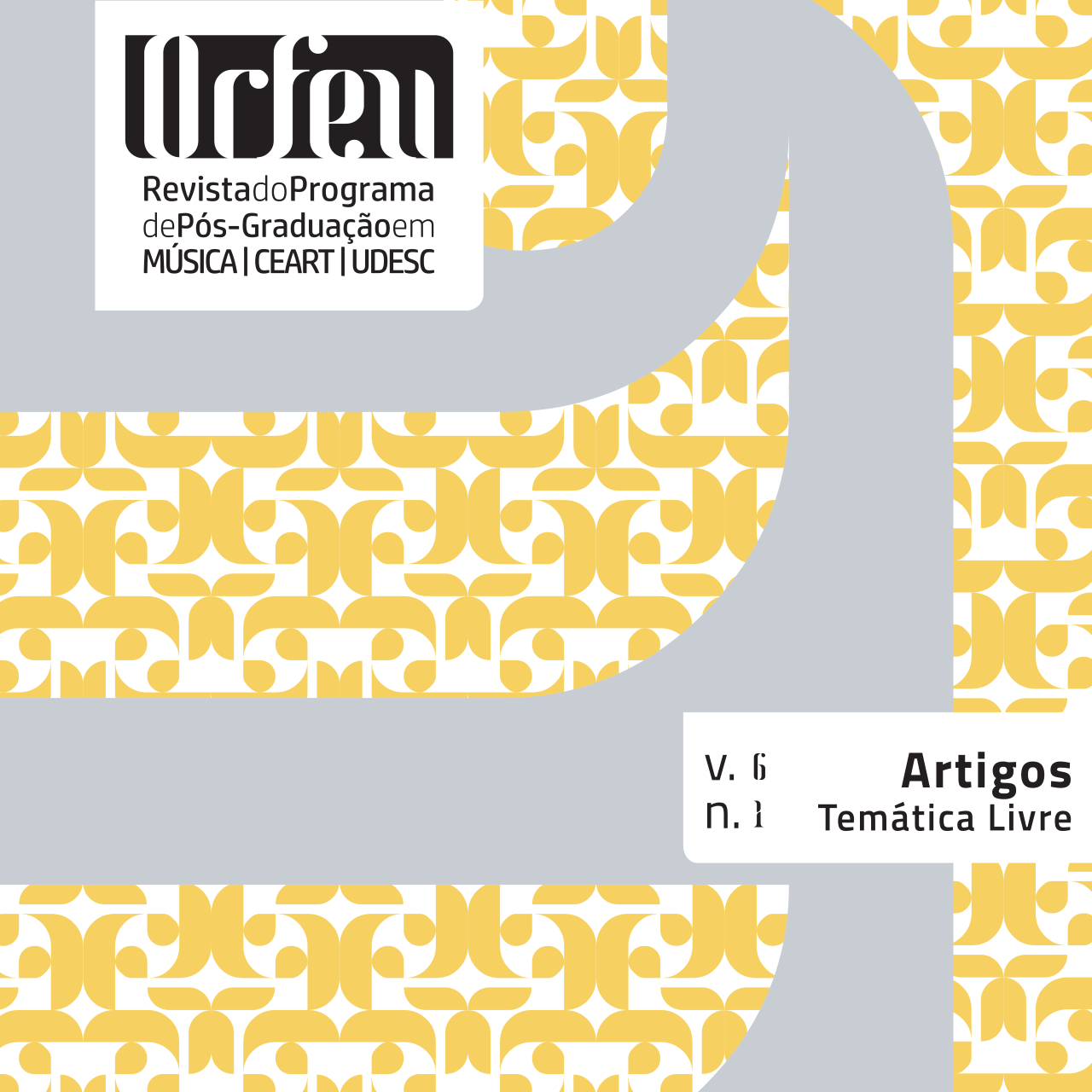Os sete pilares da técnica pianística
DOI:
https://doi.org/10.5965/2525530406012021e0001Parole chiave:
técnica pianística, consciência corporal, categorias de movimento saudávelAbstract
A técnica pianística tem sido amplamente discutida, entretanto, ainda é comum nos depararmos com crenças de que a mesma depende de fatores como o talento nato, o esforço repetitivo ou o tamanho das mãos. A perpetuação desse pensamento pode culminar em dores, lesões, problemas emocionais e até mesmo na interrupção definitiva das atividades artísticas. O presente artigo tem como objetivo analisar e sistematizar abordagens que promovem uma maneira saudável, racional e musical de se pensar a técnica pianística por meio de sete categorias ou pilares: postura corporal, coordenação dos movimentos, função do braço, movimentos semicirculares inferiores e superiores, movimentos rotatórios, deslocamento lateral progressivo no teclado e agrupamentos de leitura e realização. Conclui se que, apesar da constatação de pequenas discordâncias entre os autores, há uma convergência na busca pela eficácia pianística por meio do bem-estar físico, traduzido no desenvolvimento da consciência corporal e, consequentemente, na qualidade e variedade sonora. A categorização dos pilares promove o acesso mais claro aos conceitos analisados e permite uma maior eficiência na sua aplicação.
Downloads
Riferimenti bibliografici
BERNSTEIN, Seymour. With your two hands. New York: Schirmer Books, 1981.
BIENFAIT, Marcel. As bases da fisiologia da terapia manual. Trad.Angela Santos. 2. ed.
São Paulo: Summus, 2000.
BONPENSIERE, Luigi. New Pathways to Piano Technique. New York: Philosophical Library, 1953.
BREITHAUPT, Rudolf Maria. Natural Piano-Technique: School of Weight-Touch. 2. ed. Trad. John Bernhoff. Leipzig: C.F. Kahnt Nachfolger, 1909.
CHIANTORE, Luca. Historia de la técnica pianística. Madrid: Alianza, 2001.
DEPPE, Ludwig. Armleiden der Klavierspielen. Deutsche Musikerzeitung, p. 325, 1885.
FIELDEN, Thomas. The science of pianoforte technique. London: Macmillan and Co, 1949.
FINGER Use: Curling versus Curving - an excerpt from the Taubman 10 DVD Series. [S.l.: s. n.], 2008. 1 vídeo (1 min). Publicado pelo canal The Golandsky Institute. Disponível em: https://youtu.be/_ydx84Sp1rc. Acesso em: 17 jan. 2018.
FINK, Seymour. Mastering Piano Technique: A Guide for Students, Teachers, and Performers. Portland: Amadeus Press, 1992.
FRASER, Alan. The Craft of Piano Playing: A New Approach to Piano Technique. 2. ed. Lanham, Maryland: The Scarecrow Press, 2011.
GAT, Jozsef. The technique of piano playing. London: Collet’s, 1980.
GERIG, Reginald. Famous Pianists and Their Technique. 2. ed. Bloomington: Indiana
University Press, 2007.
KOCHEVITSKY, George. The Art of Piano Playing: A scientific approach. Miami: Summy-Bichard Company, 1967.
KOGAN, Grigory. Feruccio Busoni. Moscow: Compositores Soviéticos, 1971.
LISTER-SINK, Barbara. Let’s Get Physical: Técnica - uma conversa com Barbara Lister-Sink. [Entrevista cedida a] Scott McBride Smith. Keyboard Companion, v. 11, n. 1, Spring 2000.
LISTER-SINK, Barbara. Freeing the caged bird. Developing well-coordinated injury-preventive piano technique with Barbara Lister-Sink. Wingsound International, 2005. 1 DVD. Disponível em: www.freeingthecagedbird.com.
MARK, Thomas. What Every Pianist Needs to Know About the Body. Chicago: GIA Publications, 2003.
MATTHAY, Tobias. The act of touch in all its diversity: an analysis and synthesis of pianoforte tone-production. London: Longmans, Green and Co, 1903.
MATTHAY, Tobias. The Visible and Invisible in Pianoforte Technique. New York: Oxford University Press, 1932.
MATTHAY, Tobias. Piano fallacies of to-day. London: Oxford University Press, 1939.
MATTHAY, Tobias. The Visible and Invisible in Pianoforte Technique. 2. ed. New York: Oxford University Press, 1947.
MILANOVIC, Therese Elaine. Healthy virtuosity with the Taubman approach. APPCA Conference papper. Wagga Wagga: Charles Sturt University, 2011a.
MILANOVIC, Therese Elaine. The Taubman Approach to Piano Technique: What it is and What it isn’t. APPCA Conference paper. Wagga Wagga: Charles Sturt University, 2011b.
MILANOVIC, Therese Elaine. Learning and Teaching Healthy Piano Technique: Training as an Instructor in the Taubman Approach. Tese de doutorado. Queensland Conservatorium Arts, Education and Law. Brisbane: Griffith University, 2011c.
NEUHAUS, Henrich. The art of piano playing. Trad. K. A. Leibovich. Longwood Academic: Michigan University, 1973.
ORTMANN, Otto. The physiological mechanisms of piano technique. New York: Da Capo Press, 1929.
OSADA, Mayumi. The Lister-Sink method: A holistic approach to injury preventive piano technique. Thesis (PhD) – University of North Carolina, Greensboro, 2009.
SANDOR, Gyorgy. On piano playing: Motion, sound and expression. New York: Schirmer, 1981.
SAVSHINSKY, Samariy Ilich. O pianista e seu trabalho. Leningrado: Compositores Soviéticos, 1961.
SCHULTZ, Arnold. The riddle of the pianist’s finger and its relationship to a touch-scheme. Chicago: The University of Chicago Press, 1936.
TAUBMAN INSTITUTE. Choreography of the hands: The work of Dorothy Taubman. Amherst, MA: Sawmill River Productions, 1986. 1 vídeo, extensão mp4.
TAUBMAN INSTITUTE. The Taubman Techniques: An in-depth analysis of a technique for virtuosity and prevention of injuries among musicians. Medusa, NY: Taubman Institute, 1995. Vols. 1-5. 1 vídeo, extensão mp4.
TAUBMAN INSTITUTE. Virtuosity in a box: The Taubman techniques. Medusa, NY: Taubman Institute, 2003. Vols. 6-10. 1 vídeo, extensão mp4.
TIMAKIN, Evgeny Mikhailovich. Educação do pianista. Moscow: Compositores Soviéticos, 1984.
TORRES DEL RINCÓN, Marta. La escuela anatómico-fisiológica de técnica pianística en Inglaterra y Alemania entre 1900 y 1939. Tesis (Doctorado) – Universidad Autónoma de Madrid, 2017.
WHITESIDE, Abby. Indispensables of piano playing. New York: Charles Scribner’s Sons, 1955.
WHITESIDE, Abby. On Piano Playing. Indispensables of Piano Playing, and Mastering the Chopin Etudes and Other Essays, ed, Joseph Prostakoff and Sophia Rosoff. Portland: Amadeus Press, 1997.
Downloads
Pubblicato
Come citare
Fascicolo
Sezione
Licenza
Copyright (c) 2021 Laura Boaventura Melo, Cristina Capparelli Gerling

TQuesto lavoro è fornito con la licenza Creative Commons Attribuzione 4.0 Internazionale.






